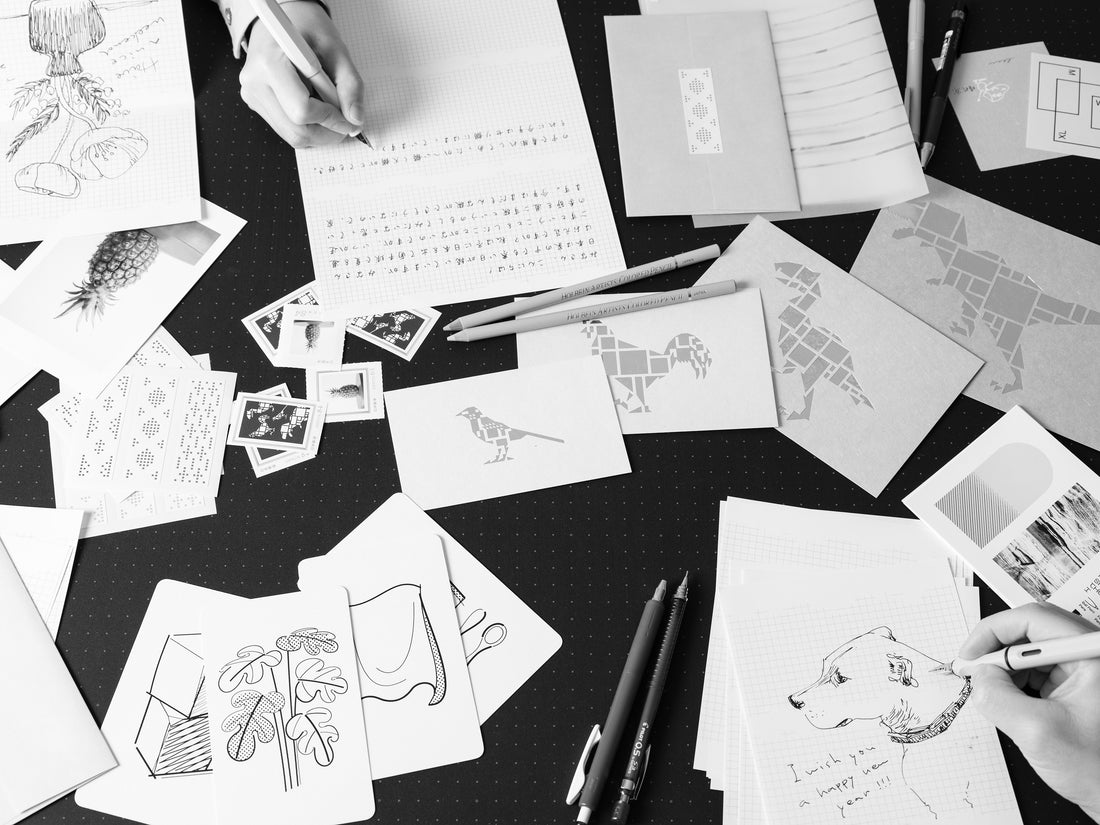
Letters as Exploration
Our first brand book, 'A Dialogue Between the Two Founders of nandaka,' is now complete. We created this book as an introduction to our brand, hoping to share the story of its inception with customers and business partners who may still be unfamiliar with us.
We invite everyone who visits our online shop to read it, so we have decided to repost the entire contents on our blog.
In this article (Chapter 1), we will discuss the background of starting nandaka and what drew us to letters.

1. Letters as Exploration
TH:
Hello everyone. We are wife and husband, and we make stationeries, especially letter stationeries, under the name called nandaka. In this booklet, we'll talk about the brand's background and how we designed its products.
HK:
I love the Japanese word ’nandaka’. For a single word in English, it would be ‘somehow.’ I use it when conveying a thought or idea to someone that I can’t immediately put into words, asking myself if it’s not like this or that. Or when something somehow comes up in my mind that I can’t explain. It is a word that we cherish very much because our project itself started with this word, and it contains what we consider to be the core of the significance and value of the letter.
TH:
Originally, we focused on letter stationeries because you liked writing and receiving letters, Hitomi, right?
HK:
Yeah, I have a lot to say about that. First of all, from the point of view of receiving a letter, it is the best present for me.
TH:
You once showed me some biscuit tins with all the letters you'd received, which was quite a lot.
HK:
I have kept them since elementary school. Sometimes when I read them back, they make me laugh and cry, giving me the power to live.
I think the value of a letter is that it can directly express the many facets of human nature. I like the fact that individuality overflows unexpectedly. Every time I receive a letter, I get a surprise. I’m surprised at the gap between the writer’s handwriting and atmosphere, or there are people whose tone of voice differs from usual. One of my friends sent me cards with completely unconnected designs as she couldn’t finish in one card. It’s also enjoyable to see their personalities in their improvisation and flexibility.
TH:
That's true. There are many things to see as they can write however they want.
HK:
So the more time passes, the more you can feel going back in time. When you look back at letters you received in the past, you can recall not only the writer but also the atmosphere of that period tangibly because of the use of language and pens that were popular at the time but are no longer in use.
It's a different feeling to look back at a photo. Photographs can be reproduced, whether film or data, but a letter is a genuine one-off item. The fact that it is both precious and nostalgic, as it is only in your possession, is a good thing that you can't find anywhere else.
TH:
Right, so all of our products are designed to be something you can look back on decades later and is still good.

HK:
Yeah, that's one of our aims. Now can I also talk about why I value letters from a writing perspective? Which shall I talk about first...... A very personal but huge reason is that letters are the most natural way of communication for me.
I would say I’m a careful person in communication. I want to be all ears when someone is speaking, and I also want to convey what I want to say well. I tend to value each dialogue’s content more than its tempo. I want to be careful not to hurt the other person because once the words have been spoken, you cannot erase them. And I want to accurately convey the feelings and nuances I genuinely want to express. In that respect, letters allow me to concentrate on slowly examining and searching for the right words, so I can be as careful as I want [laughs].
TH:
Does it also differ from communicating via email or texting apps?
HK:
While texting, I can be more careful than face-to-face conversations, which is fine but has another problem. I worry that I might seem cold, so I usually add facial expressions with emojis and stickers. As a child, people around me said I didn’t look happy or expressionless, so I started forcing myself to make a face. That may have affected me. But with a letter, my handwriting makes expressions enough, so I don’t have to try too hard. I can comfortably end with a kuten (period in Japanese) [laughs].
In my opinion, using emojis and stickers in digital communication has a creative side, but you might lose precision. It’s not something you weave yourself, it’s something you choose from a selection of prepared ones, and sometimes you end up moving away from the emotions and nuances that you really want to write.
TH:
I agree with that. I have found so far in making letter stationeries that writing is an exercise. You explore your inner self as you move your hand holding a pen. The movement of the hand helps you to find the words.
I often see expressions like, letters have a warmth, unlike emails or texting apps. I generally agree, but I don't think this means that the letter itself is inherently a medium with warmth. If warmth can be felt from analogue letters, it is through the mechanism of like, taking the time to write by hand, as if the writer is exploring their own inner self, or getting closer to their soul, and as a result, having the warmth.

HK:
We have had many such discussions. I recall the phrase “writing is an exercise” when the writing gets going. As I write a lot, I get a feeling similar to a runner’s high in a marathon race. It sharpens my mind and allows me to immerse myself in silence.
TH:
I’ll talk about this again later, I don’t think I’m a good letter writer. ...Yeah I know I’m running a letter stationery business [laughs], but for people like me, if you have a letter stationery that can take you on a runner’s high and that you feel suits you, it might open a new door for you to express yourself.
HK:
It’s so true. In that sense, we are making tools and foundations for letters.
TH:
We’d love to make good tools and help you to write letters freely and happily. So what is specifically our methodology for designing these ‘tools’, for example? We’ll talk about that in the next chapter!
